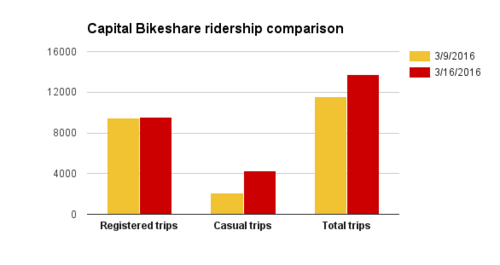
When Metro shut down on March 16th, it made life tougher on thousands of commuters. But there was a silver lining: the opportunity to see how other parts of our region’s transportation network would handle new demand.
Capital Bikeshare data from that day informed a mapping tool and several animations by Mobility Lab’s senior tech advisor, Michael Schade, which provide some insight on how the bikeshare system fits within the broader regional network. The map gives an idea of which bikeshare stations had major jumps in ridership (such as those downtown and in NoMa), and which ones were negatively affected by the lack of Metro riders.
Looking broadly, the overall bikeshare ridership grew by 21 percent compared to the previous Wednesday, March 9. (It’s worth noting, for comparison purposes, that both days had unseasonably warm and sunny weather.) Almost all of this increase came from a more-than-doubling of casual bikeshare trips: registered trips grew by only 1 percent. One possible explanation for the low increase in registered trips could be the higher likelihood that registered riders own personal bikes. In an effort to make more bikeshare bikes available, those with their own bikes were encouraged to ride those instead. Additionally, Capital Bikeshare made casual trips, normally $8 for 24 hours, free for the day.If you're one of the 50% of our members with your own bike, we encourage you to ride it. It's gonna be a busy day https://t.co/JFJbX3zFzA
— Capital Bikeshare (@bikeshare) March 16, 2016
While tourists and visitors to the DC area are typically the ones considered as “casual” bikeshare riders, on the day without Metro the category grew to include a massive number of residents trying out the system for the first time.
On a station-by-station scale, 223 (or 63 percent) of all 354 stations saw a jump in traffic on March 19. Trip decreases from certain bikeshare stations could offer a possible insight into where Capital Bikeshare riders typically connect to Metrorail. Some stations near Metro, such as a few in the Golden Triangle area of DC near Farragut West, saw decreases, but the decrease was not uniform or widespread enough to show any particular relation to Metro. Other factors, such as schools canceling classes or employers allowing telework, would have had a major impact on bikeshare ridership as well.
Given the multitude of factors, and the unique situation of the shutdown, it is difficult to determine some of these exact patterns behind ridership. But the overall jump in casual ridership does make clear: without Metro, many commuters explored a new transportation option through bikeshare.
For more Capital Bikeshare-based data projects, you can check out Mobility Lab’s upcoming Transportation Techies meeting on April 28.
Bike counts in the interactive map courtesy of the BikeArlington Counter Dashboard.
This post originally ran on Mobility Lab.
